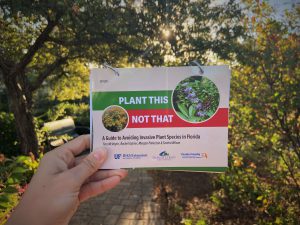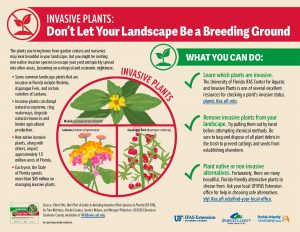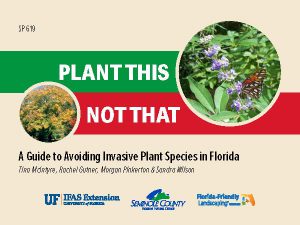By Tina McIntyre, MS, CEP, FCHP, Florida Friendly Landscaping Agent & Dr. Morgan Pinkerton, DPM, Sustainable Agriculture and Food Systems Agent; University of Florida IFAS Extension Seminole County
 Don’t wait, get your copy of this great resource from the UF/IFAS Bookstore today: https://bit.ly/AvoidInvasive.
Don’t wait, get your copy of this great resource from the UF/IFAS Bookstore today: https://bit.ly/AvoidInvasive.
What are invasive plants?
An invasive plant is defined by the Florida Department of Agriculture and Consumer Services (FDACS) as a plant which sustains itself outside of cultivation and expands its range into and within Floridian ecosystems. These invasive species can degrade our natural resources, cause management problems in agricultural fields, and can be very costly.
 How are invasive plant species introduced?
How are invasive plant species introduced?
The ornamental plant industry is the primary pathway for movement of non-native plants worldwide, with invasives accounting for a significant portion of the inventory and revenue. For example, Rose Peppertree (formerly Brazilian Peppertree), Schinus terebinthifolia, was introduced to Florida as an ornamental plant in the mid-1800s that later escaped cultivation. With a quick growth rate, wide climate tolerance, profuse seed production, and a high germination rate, this plant rapidly displaces native vegetation.
A new book can help you!
There is a new book at the University of Florida IFAS Extension Bookstore that can help you select the right non-invasive plants! Plant This Not That: A Guide to Avoiding Invasive Plant Species in Florida is a field-friendly guide that features over 20 entries, each detailing a commercially available invasive plant. Each entry contains:
- the common and scientific names of the plant
- a description of its appearance, growth habit, distribution, and range in Florida
- the ecological implications of the plant
- alternative plants or approved cultivars to plant instead
 What else you can do?
What else you can do?
You can play a part in fostering a sustainable landscape by selecting plants that will reduce the prevalence of invasive species! To help in the fight against invasive plants, you can:
- recognize and remove invasive species from the landscape
- learn the differences between common names, scientific names, and cultivars
- use alternatives to invasive species, such as native plants or sterile, non-invasive cultivars
- practice Florida-Friendly Landscaping™ principles by ensuring that you’re choosing the right plant for the right place
- participate in invasive species round ups or educational events
- get involved with your local Cooperative Invasive Species Management Areas (CISMA).
- in Central Florida, follow Central Florida CISMA and UF/IFAS Extension Seminole County on Facebook for upcoming classes and educational content
- if you have a question, talk with your local UF/IFAS Extension Office and/or Master Gardener Volunteer
 1
1
